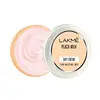What's inside
What's inside
 Key Ingredients
Key Ingredients

 Benefits
Benefits

 Concerns
Concerns

 Ingredients Side-by-side
Ingredients Side-by-side

Water
Skin ConditioningHydrogenated Polydecene
EmollientCaprylic/Capric Triglyceride
MaskingDimethicone
EmollientGlycerin
HumectantButylene Glycol
HumectantCetearyl Olivate
Sorbitan Olivate
EmulsifyingCyclopentasiloxane
EmollientMarrubium Vulgare Extract
Skin ConditioningHydrolyzed Hyaluronic Acid
HumectantOlea Europaea Fruit Oil
MaskingTocopheryl Acetate
AntioxidantAscorbyl Palmitate
AntioxidantLeuconostoc/Radish Root Ferment Filtrate
AntimicrobialPhospholipids
Skin ConditioningIsopropyl Lauroyl Sarcosinate
Skin ConditioningCetearyl Alcohol
EmollientSodium Polyacrylate
Absorbent1,2-Hexanediol
Skin ConditioningCaprylyl Glycol
EmollientPolymethylsilsesquioxane
Isohexadecane
EmollientGlyceryl Stearate
EmollientPEG-100 Stearate
Cetearyl Methicone
Skin ConditioningPhenoxyethanol
PreservativePEG-40 Stearate
EmulsifyingSteareth-2
EmulsifyingSteareth-21
CleansingRetinyl Palmitate
Skin ConditioningLinoleic Acid
CleansingLycopene
AntioxidantWater, Hydrogenated Polydecene, Caprylic/Capric Triglyceride, Dimethicone, Glycerin, Butylene Glycol, Cetearyl Olivate, Sorbitan Olivate, Cyclopentasiloxane, Marrubium Vulgare Extract, Hydrolyzed Hyaluronic Acid, Olea Europaea Fruit Oil, Tocopheryl Acetate, Ascorbyl Palmitate, Leuconostoc/Radish Root Ferment Filtrate, Phospholipids, Isopropyl Lauroyl Sarcosinate, Cetearyl Alcohol, Sodium Polyacrylate, 1,2-Hexanediol, Caprylyl Glycol, Polymethylsilsesquioxane, Isohexadecane, Glyceryl Stearate, PEG-100 Stearate, Cetearyl Methicone, Phenoxyethanol, PEG-40 Stearate, Steareth-2, Steareth-21, Retinyl Palmitate, Linoleic Acid, Lycopene
Water
Skin ConditioningCyclopentasiloxane
EmollientSorbitol
HumectantCaprylic/Capric Triglyceride
MaskingStearic Acid
CleansingHelianthus Annuus Seed Oil
EmollientIsohexadecane
EmollientGlycol Stearate
EmollientDimethicone
EmollientTriethanolamine
BufferingSodium Acrylate/Sodium Acryloyldimethyl Taurate Copolymer
Emulsion StabilisingGlyceryl Stearate
EmollientPhenoxyethanol
PreservativeParfum
MaskingCetyl Alcohol
EmollientMethylparaben
PreservativeCarbomer
Emulsion StabilisingTitanium Dioxide
Cosmetic ColorantDimethiconol
EmollientPolysorbate 80
EmulsifyingTocopheryl Acetate
AntioxidantPropylparaben
PreservativeXanthan Gum
EmulsifyingDisodium EDTA
BHT
AntioxidantPrunus Persica Fruit Extract
AbrasiveStearamide Amp
Linalool
PerfumingButylphenyl Methylpropional
PerfumingAlpha-Isomethyl Ionone
PerfumingCitronellol
PerfumingCI 14700
Cosmetic ColorantWater, Cyclopentasiloxane, Sorbitol, Caprylic/Capric Triglyceride, Stearic Acid, Helianthus Annuus Seed Oil, Isohexadecane, Glycol Stearate, Dimethicone, Triethanolamine, Sodium Acrylate/Sodium Acryloyldimethyl Taurate Copolymer, Glyceryl Stearate, Phenoxyethanol, Parfum, Cetyl Alcohol, Methylparaben, Carbomer, Titanium Dioxide, Dimethiconol, Polysorbate 80, Tocopheryl Acetate, Propylparaben, Xanthan Gum, Disodium EDTA, BHT, Prunus Persica Fruit Extract, Stearamide Amp, Linalool, Butylphenyl Methylpropional, Alpha-Isomethyl Ionone, Citronellol, CI 14700
Ingredients Explained
These ingredients are found in both products.
Ingredients higher up in an ingredient list are typically present in a larger amount.
This ingredient is an emollient, solvent, and texture enhancer. It is considered a skin-softener by helping the skin prevent moisture loss.
It helps thicken a product's formula and makes it easier to spread by dissolving clumping compounds.
Caprylic Triglyceride is made by combining glycerin with coconut oil, forming a clear liquid.
While there is an assumption Caprylic Triglyceride can clog pores due to it being derived from coconut oil, there is no research supporting this.
Learn more about Caprylic/Capric TriglycerideCyclopentasiloxane, or D5, is a silicone used to improve texture of products and trap moisture.
D5 is considered lightweight and volatile. Volatile means it evaporates quickly after application. Once evaporated, D5 leaves a thin barrier that helps keep skin hydrated.
It is also an emollient. Emollients help soften the skin and prevent water loss. Silicones create a silky texture in products. D5 helps other ingredients become more spreadable.
Studies show D5 is safe to use in skincare products. We recommend speaking with a skincare professional if you have concerns.
Learn more about CyclopentasiloxaneDimethicone is a type of synthetic silicone created from natural materials such as quartz.
What it does:
Dimethicone comes in different viscosities:
Depending on the viscosity, dimethicone has different properties.
Ingredients lists don't always show which type is used, so we recommend reaching out to the brand if you have questions about the viscosity.
This ingredient is unlikely to cause irritation because it does not get absorbed into skin. However, people with silicone allergies should be careful about using this ingredient.
Note: Dimethicone may contribute to pilling. This is because it is not oil or water soluble, so pilling may occur when layered with products. When mixed with heavy oils in a formula, the outcome is also quite greasy.
Learn more about DimethiconeGlyceryl Stearate is a mix of glycerin and stearic acid.
It is used to stabilize the mixing of water and oil ingredients. By preventing these ingredients from separating, it can help elongate shelf life. It can also help thicken the product's texture.
As an emollient, it helps soften skin and supports barrier-replenishing ingredients.
In cosmetics, Glyceryl Stearate is often made from vegetable oils or synthetically produced.
This ingredient may not be fungal-acne safe
Fun fact: The human body also creates Glyceryl Stearate naturally.
Learn more about Glyceryl StearateIsohexadecane is added to enhance texture, emulsify, and to help cleanse. It is an isoparrafin. It is a component of petrolatum.
Due to its large size, Isohexadecane is not absorbed by the skin. Instead, it sits on top and acts as an emollient. Emollients help keep your skin soft and smooth by trapping moisture within.
Isohexadecane is often used in products designed to help oily skin. It is lightweight and non-greasy while helping to moisturize. When mixed with silicones, it gives a product a silky feel.
Learn more about IsohexadecanePhenoxyethanol is a preservative that has germicide, antimicrobial, and aromatic properties. Studies show that phenoxyethanol can prevent microbial growth. By itself, it has a scent that is similar to that of a rose.
It's often used in formulations along with Caprylyl Glycol to preserve the shelf life of products.
Tocopheryl Acetate is AKA Vitamin E. It is an antioxidant and protects your skin from free radicals. Free radicals damage the skin by breaking down collagen.
One study found using Tocopheryl Acetate with Vitamin C decreased the number of sunburned cells.
Tocopheryl Acetate is commonly found in both skincare and dietary supplements.
Learn more about Tocopheryl AcetateWater. It's the most common cosmetic ingredient of all. You'll usually see it at the top of ingredient lists, meaning that it makes up the largest part of the product.
So why is it so popular? Water most often acts as a solvent - this means that it helps dissolve other ingredients into the formulation.
You'll also recognize water as that liquid we all need to stay alive. If you see this, drink a glass of water. Stay hydrated!
Learn more about Water